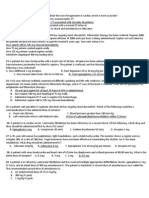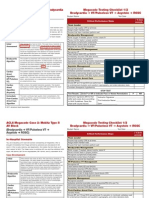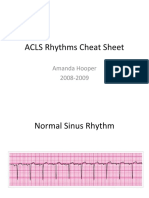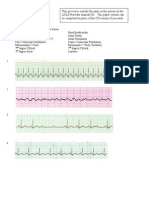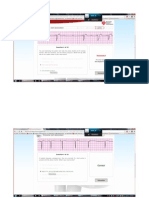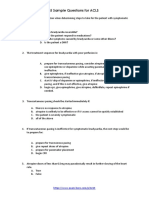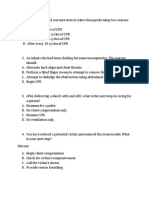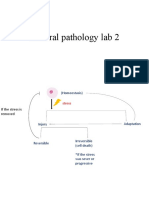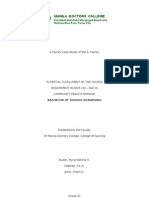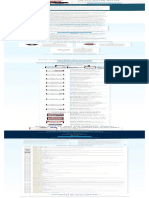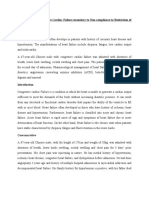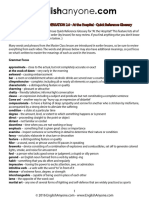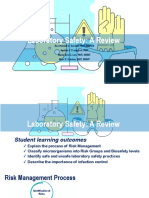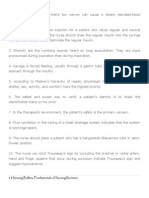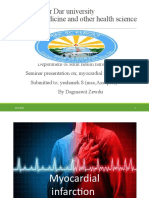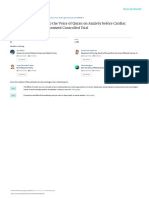American Heart Association: Precourse Written Examination May 2001
American Heart Association: Precourse Written Examination May 2001
Uploaded by
Ericka SwordCopyright:
Available Formats
American Heart Association: Precourse Written Examination May 2001
American Heart Association: Precourse Written Examination May 2001
Uploaded by
Ericka SwordOriginal Description:
Original Title
Copyright
Available Formats
Share this document
Did you find this document useful?
Is this content inappropriate?
Copyright:
Available Formats
American Heart Association: Precourse Written Examination May 2001
American Heart Association: Precourse Written Examination May 2001
Uploaded by
Ericka SwordCopyright:
Available Formats
American Heart Association
Advanced Cardiovascular
Life Support
Precourse Written
Examination
May 2001
© 2001 American Heart Association
ACLS Provider Course
Precourse Written Examination
This is a single-answer multiple-choice examination. There is only one correct answer to each
question. Do not write on this question sheet. Circle the correct answer on your answer sheet.
1. Which of the following actions is done first to restore oxygenation and ventilation to
an unresponsive, breathless, near-drowning victim?
a. force water from the victim's lungs by performing the Heimlich maneuver
b. force water from the victim’s lungs by starting chest compressions
c. stabilize cervical spine with c-collar and spine board, then start the ABCs
d. open the airway with a jaw-thrust maneuver, provide in-line cervical stabilization, start
the ABCs
2. Tracheal intubation has just been attempted for a victim of respiratory arrest. During
hand ventilation with a bag, you hear stomach gurgling over the epigastrium, and
oxygen saturation (per pulse oximetry) fails to rise. Which of the following is the
most likely explanation for these findings?
a. intubation of the hypopharyngeal area
b. intubation of the left main bronchus
c. intubation of the right main bronchus
d. bilateral tension pneumothorax
3. Which of the following patients needs immediate intubation?
a. an elderly woman with severe chest pain and shallow respirations at 30 breaths/min
b. a 55-year-old insulin-dependent diabetic with ST-segment elevation and runs of VT
c. an apneic patient whose chest does not rise with bag-mask ventilations
d. a subdued, alcohol-intoxicated college student with a reduced gag reflex
4. When treating a trauma victim who is in shock and deeply comatose, which of the
following is the airway of choice?
a. a tracheal tube
b. the patient's own airway
c. a nasopharyngeal airway
d. an oropharyngeal airway
ACLS Provider Course Precourse Exam 2
5. Which of these lists of CPR performance and AED operation is correct and in the right
sequence?
a. send someone to call 911, attach AED electrode pads, open the airway, turn on the
AED, provide 2 breaths, check for a pulse
b. wait for the AED and barrier device to arrive, open the airway, provide 2 breaths, check
for a pulse, if no pulse attach AED electrode pads, follow AED prompts
c. send someone to call 911, open the airway, provide 2 breaths, check for a pulse, if no
pulse attach the AED, follow AED prompts
d. provide 2 breaths, check for a pulse, if no pulse perform chest compressions for 1
minute, call for the AED, when the AED arrives attach electrode pads
6. You are operating an AED in an attempted resuscitation of a man who collapsed in
the airport. After delivery of 3 successive shocks, your pulse check indicates he still
lacks a pulse. What is the next thing you do?
a. reanalyze the victim’s rhythm
b. perform CPR until EMS personnel arrive
c. perform CPR for 1 minute, then reanalyze the victim's rhythm
d. leave the AED attached and start transport to the nearest ED, stopping every 3 minutes
for the AED to reanalyze
7. A patient remains in VF cardiac arrest after 3 stacked shocks, tracheal intubation,
epinephrine 1 mg IV, and a 4th shock. Which of the following drug-dose combina-
tions should this patient receive next?
a. amiodarone 150 mg IV given over 10 minutes
b. lidocaine 1 to 1.5 mg/kg IV push
c. procainamide 50 mg/min, up to a total dose of 17 mg/kg
d. magnesium 1 to 2 g, appropriately diluted, IV push
8. A patient in VF cardiac arrest has failed to respond to 3 shocks, epinephrine 1 mg IV,
and a 4th shock. You give the medication nurse a “standing order” to administer
epinephrine every 3 minutes as long as the resuscitation continues. Which of the
following dose regimens is recommended?
a. epinephrine 1 mg, 3 mg, 5 mg, and 7 mg (escalating regimen)
b. epinephrine 0.2 mg/kg per dose (high-dose regimen)
c. epinephrine 1 mg IV push, repeated every 3 minutes
d. epinephrine 1 mg IV push, followed in 3 minutes by vasopressin 40 U IV
ACLS Provider Course Precourse Exam 3
9. EMTs arrive at the side of a 55-year-old man in cardiac arrest. The first AED analysis
registers “shock indicated.” But before the shock can be delivered, the EMTs learn
that the man has gone 12 minutes without any bystander CPR. What actions should
the EMTs take next?
a. resume CPR, supplement with 100% O2, continue until paramedics arrive
b. allow the AED to charge and shock
c. resume CPR, supplement with 100% O2 for 3 minutes, reanalyze, shock if indicated
d. resume CPR, contact medical control, request permission to stop resuscitative efforts
10. While treating a patient in persistent VF arrest after 3 shocks, you consider using
vasopressin. Which of the following guidelines for use of vasopressin is true?
a. give vasopressin 40 U every 3 to 5 minutes
b. give vasopressin for better vasoconstriction and β-adrenergic stimulation than provided
by epinephrine
c. give vasopressin as an alternative to epinephrine in shock-refractory VF
d. give vasopressin as the first-line pressor agent for clinical shock caused by
hypovolemia
11. A patient arrives in the ED. CPR continues with ventilations provided through a
tracheal tube inserted in the field. Chest compressions produce a femoral pulse that
disappears during a “stop compressions” pause. During the pause the cardiac
monitor shows narrow QRS complexes at a rate of 65 bpm. At this point what is the
next action you should take?
a. check for tracheal tube dislodgment and improper tube placement
b. start an IV, administer atropine 1 mg IV push
c. start an IV, send blood samples for measurement of serum electrolytes and a toxic drug
screen
d. analyze arterial blood gases to check for acidosis, hypoxia, and hypoventilation
12. You have intubated a patient with PEA. You hear good bilateral breath sounds, and
you see obvious bilateral chest rise. Two minutes after epinephrine 1 mg IV is given,
PEA continues at 30 bpm. Which of the following actions should be done next?
a. administer atropine 1 mg IV
b. initiate transcutaneous pacing at a rate of 60 bpm
c. start a dopamine IV infusion at 15 to 20 µg/kg per minute
d. give epinephrine (1 mL of 1:10 000 solution) IV bolus
ACLS Provider Course Precourse Exam 4
13. For which of the following PEA patients is sodium bicarbonate therapy (1 mEq/kg)
likely to be most effective?
a. a patient with hypercarbic acidosis due to a tension pneumothorax
b. a patient with a brief arrest interval
c. a patient with documented severe hyperkalemia
d. a patient with documented severe hypokalemia
14. A cardiac arrest patient arrives in the ED in PEA at 30 bpm. CPR continues, proper
tube placement is confirmed, and IV access is established. Which of the following
medications is most appropriate to give next?
a. calcium chloride 5 mL of 10% solution IV
b. epinephrine 1 mg IV
c. synchronized cardioversion at 200 J
d. sodium bicarbonate 1 mEq/kg IV
15. Which of the following drug-dose combinations is recommended as the initial
medication to give to a patient in documented asystole?
a. epinephrine 3 mg IV
b. atropine 3 mg IV
c. epinephrine 10 mL of a 1:10 000 solution IV
d. atropine 0.5 mg IV
16. When a monitor attached to a person in cardiac arrest displays a “flat line,” you
should execute the "flat line protocol." Which of the following actions is included in
this protocol?
a. check monitor display for sensitivity or “gain”
b. obtain a right-sided 12-lead ECG
c. change LEAD SELECT control from lead II to paddles and back
d. administer a lower energy (100 J) defibrillatory shock to “bring out” possible occult VF
ACLS Provider Course Precourse Exam 5
17. An 88-year-old man in normothermic cardiac arrest arrives in the ED after 15 minutes
of continuous asystole. Paramedics intubated him, confirmed proper tube place-
ment, gained IV access, and gave epinephrine 1 mg IV × 3 and atropine 1 mg IV × 2.
Which of the following actions is most likely to have a positive therapeutic effect and
is most consistent with the recommendations in ECC Guidelines 2000?
a. ask the nurse to bring members of the immediate family to a private area, where you
discuss code termination and family presence at the resuscitation
b. stop efforts at 10 minutes if there is no response to epinephrine 3 mg IV every 3
minutes
c. stop efforts at 10 minutes if there is no response to transcutaneous pacing given with
CPR
d. stop efforts if there is no response to 3 empiric defibrillatory shocks of 360 J given 3
minutes apart
18. A 50-year-old man has a 3-mm ST-elevation in leads V2 to V4. Severe chest pain
continues despite oxygen, aspirin, nitroglycerin SL × 6, and morphine 10 mg IV.
BP = 170/110 mm Hg; HR = 120 bpm. Which of the following treatment combinations
is most appropriate for this patient at this time (assume no contraindications to any
medication)?
a. calcium channel blocker IV + heparin bolus IV
b. ACE inhibitor IV + lidocaine infusion
c. magnesium sulfate IV + enoxaparin (Lovenox) SQ
d. reteplase, recombinant (Retavase) + heparin bolus IV
19. Which of the following includes the major components of definitive therapy for a
60-year-old patient with >2mm ST-segment elevation within 30 minutes of the onset
of symptoms of acute ischemic chest pain?
a. fibrinolytics or PCI, aspirin, β-blockers, heparin
b. heparin, aspirin, glycoprotein IIb/IIIa inhibitors, IV β-blockers, nitrates
c. serum cardiac markers, serial ECGs, perfusion scan or stress test
d. prophylactic lidocaine, fluid bolus, vasopressor infusion
20. Within 45 minutes of ED arrival, which of the following evaluation sequences should
be performed for a 70-year-old woman with rapid onset of headache, garbled speech,
and right arm and leg weakness?
a. history, physical and neurologic exams, noncontrast head CT with radiologist
interpretation
b. history, physical and neurologic exams, noncontrast head CT, start of fibrinolytic
treatment if scan is positive for stroke
c. history, physical and neurologic exams, lumbar puncture, contrast head CT if LP is
negative for blood
d. history, physical and neurologic exams, contrast head CT, start of fibrinolytic treatment
when improvement in neurologic signs is noted
ACLS Provider Course Precourse Exam 6
21. Which of the following conditions most closely mimics the signs and symptoms of
an acute stroke?
a. acute insulin-induced hypoglycemia
b. acute hypoxia
c. isotonic dehydration and hypovolemia
d. acute vasovagal or orthostatic hypotension
22. Which of the following rhythms is an appropriate indication for transcutaneous
cardiac pacing?
a. sinus bradycardia with no symptoms
b. normal sinus rhythm with hypotension and shock
c. complete heart block with pulmonary edema
d. asystole that follows 6 or more defibrillation shocks
23. A patient with a HR of 30 to 40 bpm complains of dizziness, cool, clammy extremi-
ties, and dyspnea with minimal exercise. What is the first drug to give to this
patient?
a. atropine 0.5 to 1 mg
b. epinephrine 1 mg IV push
c. isoproterenol infusion 2 to 10 µg/min
d. adenosine 6 mg rapid IV push
24. Which one of the following patients needs immediate synchronized cardioversion?
a. a 78-year-old woman with fever, pneumonia, chronic congestive heart failure, and sinus
tachycardia at 125 bpm
b. a 55-year-old man with multifocal atrial tachycardia at 125 bpm, respiratory rate of
12 breaths/minute, and BP of 134/86 mm Hg
c. a 69-year-old woman with a history of coronary artery disease, chest pain, a 2-mm ST
elevation, and sinus tachycardia at 130 bpm
d. a 62-year-old man with a history of rheumatic mitral valve disease, obvious shortness of
breath, HR of 160 bpm, and BP of 88/70 mm Hg
ACLS Provider Course Precourse Exam 7
25. Which one of the following patients is most likely presenting with stable tachycardia
that you should not cardiovert?
a. a 25-year-old wheezing asthmatic woman who has pneumonia on chest x-ray, who is
taking albuterol, and who has the following vital signs: temp = 101.2°F, HR = 140 bpm,
resp = 20 breaths/min
b. a 55-year-old man with diaphoresis, bilateral rales, and the following vital signs:
HR = 140 bpm, BP = 90/55 mm Hg, resp = 18 breaths/min, rhythm = rapid atrial flutter
c. a 62-year-old man with a wide-complex tachycardia at a rate of 140 bpm, chest pain,
shortness of breath, and palpitations
d. a 55-year-old woman with chest pain, shortness of breath, extreme weakness and
dizziness, BP of 88/54 mm Hg, and a narrow-complex tachycardia at a rate of 145 bpm
26. You prepare to cardiovert an unstable 48-year-old tachycardic woman with the
monitor/defibrillator in “synchronization” mode. She suddenly becomes unrespon-
sive and pulseless right when the rhythm changes to an irregular, chaotic, VF-like
pattern. You charge to 200 J and press the SHOCK button, but the defibrillator fails
to deliver a shock. Why?
a. the defibrillator/monitor battery failed
b. the “sync” switch failed
c. you cannot shock VF in “sync” mode
d. a monitor lead has lost contact, producing the “pseudo-VF” rhythm
27. An 80-year-old woman complains of palpitations and mild lightheadedness, but the
findings of her physical exam are unremarkable. The 1st ECG shows a regular,
narrow-complex tachycardia at 150 bpm. The Valsalva maneuver slows the ven-
tricular rate to reveal classic atrial flutter waves, but it does not convert the atrial
flutter. Which of the following interventions should you try next?
a. IV adenosine to slow ventricular rate
b. IV diltiazem to slow ventricular rate
c. urgent DC cardioversion
d. IV dopamine to strengthen cardiac contractions
28. A previously healthy 50-year-old man complains of chest tightness, palpitations, and
dizziness. HR is 170 bpm, BP is 90/60 mm Hg, and the ECG shows a narrow-complex
tachycardia. You decide that the rhythm is multifocal atrial tachycardia. He failed to
respond to initial vagal maneuvers and 2 rounds of adenosine. As your next action,
which of the following treatments is inappropriate ?
a. IV amiodarone
b. IV metoprolol
c. IV diltiazem
d. DC cardioversion
ACLS Provider Course Precourse Exam 8
29. A 75-year-old man presents to the ED with 1 week of lightheadedness, irregular
palpitations, and mild exercise intolerance. The initial 12-lead ECG displays atrial
fibrillation, which continues to show on the monitor at a HR of 120 to 150 bpm and
BP = 100/70 mm Hg. Which of the following therapies is the most appropriate next
intervention?
a. sedation, analgesia, then immediate cardioversion
b. oxygen via nasal cannula at 2 to 6 L/min, normal saline at 60 to 120 mL/h
c. amiodarone 300 mg IV bolus
d. metoprolol 5 mg IV; repeat every 5 minutes to a total dose of 15 mg
30. A 66-year-old, malnourished, chronic alcoholic presents with polymorphic ven-
tricular tachycardia that resembles torsades de pointes. His HR is irregular at 120 to
160 bpm, and his BP is 95/65 mm Hg. He has no related symptoms and no signs of
impaired heart function. Which of the following treatments is most appropriate at
this time?
a. IV amiodarone
b. IV magnesium
c. IV lidocaine
d. IV procainamide
31. You are performing CPR on a man in cardiac arrest when a technician arrives
and attaches an AED. With the first rhythm analysis a shock is “indicated” and
delivered, but the next rhythm analysis signals "no shock advised." What is the
most appropriate next action?
a. check for a pulse
b. press the manual OVERRIDE button and operate the AED as a manual defibrillator
c. insert an oropharyngeal airway and start 100% oxygen at 6 L/min
d. support breathing and place the patient in the recovery position until the hospital code
team arrives
32. Which of the following patients is most likely to present with vague signs and
unusual symptoms of an atypical AMI?
a. a 65-year-old woman with moderate coronary artery disease recently confirmed by
angiography
b. a 56-year-old man who smokes 3 packs per day but has no history of heart disease
c. a 45-year-old woman diagnosed with type I diabetes 22 years ago
d. a 48-year-old man in the ICU after coronary artery bypass surgery
ACLS Provider Course Precourse Exam 9
33. A 60-year-old man (weight = 50 kg) with a history of recurrent VF has converted
from VF to a wide-complex perfusing rhythm after epinephrine 1 mg IV and a 4th
shock (HR = 60 bpm, BP = 90/60 mm Hg). Which of the following drug regimens is
most appropriate to give next?
a. amiodarone 300 mg IV push
b. adenosine 6 mg rapid IV push
c. magnesium 3 g IV push, diluted in 10 mL of D5W
d. procainamide 20 to 50 mg/min, up to a maximum dose of 17 mg/kg
ACLS Provider Course Precourse Exam 10
You might also like
- ACLS Cheat SheetDocument8 pagesACLS Cheat SheetLenTheRN86% (28)
- ACLS Post TestDocument6 pagesACLS Post TestSheila Tolentino-Belanio73% (79)
- Acls Pre Course Self Assessment Study GuideDocument7 pagesAcls Pre Course Self Assessment Study Guidenova939100% (11)
- AHA ELearning ACLS Precourse Self-Assessment and Precourse WorkDocument1 pageAHA ELearning ACLS Precourse Self-Assessment and Precourse Work9kjsntkrzcNo ratings yet
- AHA ACLS Megacode ScenariosDocument6 pagesAHA ACLS Megacode ScenariosChad Sanford78% (18)
- ACLS Pretest Questions and Answers 2020 (Full Practice Test)Document23 pagesACLS Pretest Questions and Answers 2020 (Full Practice Test)김민길50% (4)
- ACLS Exam ADocument8 pagesACLS Exam ASean Johnson81% (31)
- ACLS Review TestDocument5 pagesACLS Review Testtostc60% (5)
- ACLS Answer KeyDocument23 pagesACLS Answer KeyKirana Budhiarta94% (17)
- American Heart Association Acls Post Test AnswersDocument4 pagesAmerican Heart Association Acls Post Test AnswersArun Jude Alphonse0% (10)
- ACLS PharmacologyDocument6 pagesACLS PharmacologyEunice Angela Fulgueras88% (8)
- ACLS - Precourse Questions and AnswersDocument18 pagesACLS - Precourse Questions and Answerssuperdockk58% (12)
- 2021 ACLS Study GuideDocument20 pages2021 ACLS Study GuideShane Brown88% (16)
- ACLS Rhythms Cheat SheetDocument21 pagesACLS Rhythms Cheat SheetShannon Hagan Wilson100% (8)
- ACLS PrecourseAssessmentDocument19 pagesACLS PrecourseAssessmentBrigitte Elaine81% (21)
- ACLS Practice Test 1Document6 pagesACLS Practice Test 1tarrynwortmann5319100% (3)
- FREE 2022 ACLS Study Guide - ACLS Made Easy! PDFDocument18 pagesFREE 2022 ACLS Study Guide - ACLS Made Easy! PDFkumar23100% (2)
- TestDocument11 pagesTestzenagit123456100% (1)
- ACLS2Document7 pagesACLS2Jennifer Kaye L. DucaoNo ratings yet
- Cals ReviewbjvjvjDocument14 pagesCals ReviewbjvjvjCarl Jay M Ocariza100% (1)
- Acls QuestionsDocument28 pagesAcls QuestionsDsd100% (1)
- ACLS Pretest Exam AnnotatedDocument21 pagesACLS Pretest Exam AnnotatedMOLLYNo ratings yet
- ACLS PrecourseAssessmentDocument19 pagesACLS PrecourseAssessmentRaiedKhaled100% (2)
- ACLS Rhythms Practice Test 2020 Recognition Rhythm Strips (PDF)Document11 pagesACLS Rhythms Practice Test 2020 Recognition Rhythm Strips (PDF)김민길100% (3)
- Acls Test: 1. Start CPR, Beginning With Chest CompressionsDocument15 pagesAcls Test: 1. Start CPR, Beginning With Chest CompressionsBoby Jomol100% (11)
- ACLS Post Test (Copy) 낱말 카드 - QuizletDocument18 pagesACLS Post Test (Copy) 낱말 카드 - Quizlet김민길100% (2)
- ACLS Algorithms 2020 (Advanced Cardiac Life Support)Document1 pageACLS Algorithms 2020 (Advanced Cardiac Life Support)evelyn k100% (2)
- ACLS Megacode Testing ScenariosDocument12 pagesACLS Megacode Testing Scenariosealm10100% (2)
- Acls DrugsDocument10 pagesAcls DrugsChintami Octavia100% (1)
- ACLS 2020 Algorithms: American Heart Association 2020 GuidelinesDocument8 pagesACLS 2020 Algorithms: American Heart Association 2020 GuidelinesNofi Nurina100% (4)
- Acls Version B QuizDocument9 pagesAcls Version B QuizRokunuz Jahan Rudro0% (1)
- Acls ExamDocument42 pagesAcls ExamScribdTranslations50% (2)
- 12 To 24 HoursDocument45 pages12 To 24 HoursstellaNo ratings yet
- This Is A Single-Answer Multiple-Choice Examination. There Is Only One Correct Answer To Each QuestionDocument8 pagesThis Is A Single-Answer Multiple-Choice Examination. There Is Only One Correct Answer To Each QuestionUgeshwaran Aristotle Reddy50% (2)
- ACLS Practice TestDocument5 pagesACLS Practice Testprettynpink0867% (3)
- Advanced Cardiac Life Support Quick Study Guide 2015 Updated GuidelinesFrom EverandAdvanced Cardiac Life Support Quick Study Guide 2015 Updated GuidelinesRating: 4 out of 5 stars4/5 (6)
- Pediatric Advanced Life Support Quick Study Guide 2015 Updated GuidelinesFrom EverandPediatric Advanced Life Support Quick Study Guide 2015 Updated GuidelinesRating: 5 out of 5 stars5/5 (2)
- 2011 ACLS Pretest Annotated Answer KeyDocument19 pages2011 ACLS Pretest Annotated Answer KeyMohammed Abdou92% (13)
- ACLS ECGsDocument4 pagesACLS ECGsEman Elzeftawy100% (7)
- ACLS NotesDocument9 pagesACLS Notestasha0% (1)
- ACLSDocument17 pagesACLSms_lezah100% (4)
- Pals With Bls 2016Document53 pagesPals With Bls 2016Etcvh Gvbj100% (2)
- ACLS Test PrintscreenedDocument13 pagesACLS Test Printscreenedhellfireomega67% (9)
- Acls AllDocument71 pagesAcls Allezzat salemNo ratings yet
- Rhythm Recognition - ACLS Medical Training 1Document9 pagesRhythm Recognition - ACLS Medical Training 1Catalina BorquezNo ratings yet
- ACLS Test QuestionsDocument2 pagesACLS Test QuestionsNyle GreyNo ratings yet
- ACLS Exam ADocument8 pagesACLS Exam AAgil Rumboko Sumitro100% (4)
- ACLS PharmacologyDocument5 pagesACLS PharmacologyKuruva MallikarjunaNo ratings yet
- Acls Pretest Answer Key: Rhythm Identification (Part I)Document3 pagesAcls Pretest Answer Key: Rhythm Identification (Part I)aditNo ratings yet
- ACLS QuizletDocument7 pagesACLS Quizletek.9006001No ratings yet
- ACLS Instr Fac GuideDocument43 pagesACLS Instr Fac GuideOnek KothaNo ratings yet
- Acls - Megacode - UpdatedDocument4 pagesAcls - Megacode - UpdatedDivine Dela Pena100% (3)
- BLS Training - Question PaperDocument3 pagesBLS Training - Question PaperNav J Kar100% (3)
- Advance Cardiac Life Support: Short, Sweet and to the PointFrom EverandAdvance Cardiac Life Support: Short, Sweet and to the PointRating: 3 out of 5 stars3/5 (2)
- Cardiac Tamponade, A Simple Guide To The Condition, Diagnosis, Treatment And Related ConditionsFrom EverandCardiac Tamponade, A Simple Guide To The Condition, Diagnosis, Treatment And Related ConditionsNo ratings yet
- Adult CCRN Exam Flashcards, Third Edition: Up-to-Date Review and PracticeFrom EverandAdult CCRN Exam Flashcards, Third Edition: Up-to-Date Review and PracticeNo ratings yet
- General Patho Lab2 2Document93 pagesGeneral Patho Lab2 2عبد الرحمن عصام ابوديابNo ratings yet
- Procedure For DefibrillationDocument6 pagesProcedure For DefibrillationTasia DeastutiNo ratings yet
- Family Nursing Care Plan & Community DXDocument65 pagesFamily Nursing Care Plan & Community DXIris Caberte80% (10)
- ECG Rhythm Master I Health And WillnessDocument1 pageECG Rhythm Master I Health And Willnessday alcoberNo ratings yet
- Understanding pharmacology essentials for medication safety 2 edition Edition Lacharity 2024 scribd downloadDocument46 pagesUnderstanding pharmacology essentials for medication safety 2 edition Edition Lacharity 2024 scribd downloaddortymodenuu100% (1)
- The Aga Khan University Hospital Pediatric SCU Course Final Exam Test Paper Name: - UnitDocument5 pagesThe Aga Khan University Hospital Pediatric SCU Course Final Exam Test Paper Name: - UnitUmar RashidNo ratings yet
- Decompensated Congestive Cardiac Failure Secondary To No1Document4 pagesDecompensated Congestive Cardiac Failure Secondary To No1Qi YingNo ratings yet
- IRON5Document11 pagesIRON5scgtm6gc46No ratings yet
- A Phase I Feasibility Study of Yoga On The Physical Health and Coping of Informal CaregiversDocument11 pagesA Phase I Feasibility Study of Yoga On The Physical Health and Coping of Informal CaregiversFranco EliasNo ratings yet
- Kr2med 2004engDocument49 pagesKr2med 2004engSuma LathaNo ratings yet
- At The Hospital Quick Reference Glossary PDFDocument12 pagesAt The Hospital Quick Reference Glossary PDFFaisal IqbalNo ratings yet
- PMLS 2 PrelimsDocument55 pagesPMLS 2 PrelimsCassey Stephane PinedaNo ratings yet
- Advanced Cardiac Life SupportDocument13 pagesAdvanced Cardiac Life SupportEldonVinceIsidroNo ratings yet
- FajtorDocument6 pagesFajtorMarshaAsmaraditaNo ratings yet
- Histologi Organ Dan Sistem Sirkulasi PoltekkesDocument28 pagesHistologi Organ Dan Sistem Sirkulasi PoltekkesJeon WonwooNo ratings yet
- 03 Cardiopulmonary PhysiologyDocument17 pages03 Cardiopulmonary Physiologyice cream1000791100% (1)
- Periodic Test in Science 4 1st - 4thDocument17 pagesPeriodic Test in Science 4 1st - 4th엘라엘라No ratings yet
- Basics of EKG InterpretationDocument132 pagesBasics of EKG InterpretationSiddhant GautamNo ratings yet
- Q4 STEM General Biology 2 Week 4Document4 pagesQ4 STEM General Biology 2 Week 4Bernard D. Fajardo Jr.0% (1)
- Nursing Bullets: Fundamentals of Nursing ReviewerDocument44 pagesNursing Bullets: Fundamentals of Nursing ReviewerErl DiamanteNo ratings yet
- Ischemic Heart Disease: Dr. Amin ShneifiDocument65 pagesIschemic Heart Disease: Dr. Amin Shneificarmitjulya228No ratings yet
- 01 - Prevention & Control of Communicable & Non-Communicable DiseaseDocument153 pages01 - Prevention & Control of Communicable & Non-Communicable DiseaseMegat Mohd Azman Adzmi100% (3)
- Bahir Dar University College of Medicine and Other Health ScienceDocument61 pagesBahir Dar University College of Medicine and Other Health ScienceGizachew AsimareNo ratings yet
- Differentiating Abbreviations From Acronyms: MuscleDocument10 pagesDifferentiating Abbreviations From Acronyms: MusclePrince Rener Velasco PeraNo ratings yet
- Effect of Quran On AnxietyDocument8 pagesEffect of Quran On Anxietyezuan wanNo ratings yet
- فەرهەنگی پزیشکی من (Kaka)Document120 pagesفەرهەنگی پزیشکی من (Kaka)mrben2596No ratings yet
- Definition:: Checking The Vital Signs (VS)Document18 pagesDefinition:: Checking The Vital Signs (VS)Loyd Tuvilla100% (1)
- 220 Triathlon UK - January 2024Document120 pages220 Triathlon UK - January 2024Omar Magdy AhmadNo ratings yet
- Delfin Leslie Pearl E. CONCEPT MAPDocument1 pageDelfin Leslie Pearl E. CONCEPT MAPJeremiah Andre Poissonier AyupanNo ratings yet
- Clinical Guidelines MSFDocument311 pagesClinical Guidelines MSFAndrea Z Milano100% (1)

